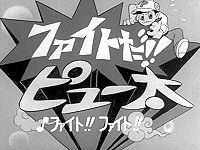
When it comes to anime from the 60s, suddenly no one can talk about it anymore, right?
Fight!! Pyuta ♪ Fight!! Fight!!
Black and white is a high hurdle.
If it’s Ashita no Joe that started in ’69…
It seems like you can watch quite a bit through subscriptions now…
I only know about Golden Bat and Yokai Ningen Bemu at most…
It’s a good opening that moves well, isn’t it?
I remember seeing parodies from time to time, but I have never watched the main story of Wolf Boy Ken at all.
The original anime, Osomatsu-kun, really had monster-like viewership ratings.
The thread image aimed for a pop and stylish feel, but it was an anime that was ahead of its time.
I only know about Black and White 009…
I can only talk about well-known tokusatsu and what’s currently being streamed.
Ultraman, Giant Robo, Strange Phenomena Operation, and the Terror of the Mummy.
In 1968, there is “Sabuku and the Municipal Crime Chronicles.”
So they were already searching for adult-oriented anime.
Mach Go Go Go or…
It has already been 69 years since Mitsuko Horie started singing anime songs.
It won’t be software-based, and even if it is, there won’t be anyone to buy it.
That’s why I think it’s okay to stream, but it’s often the case that there are no films either.
Difficult
When it turns black and white, there are patterns where the master is at a loss…
I feel like the theme songs for Super Jetter, Eightman, and Wolf Boy Ken are frequently revived or used in commercials.
I have never seen the main story.
It’s amazing how long and widely the name of Tsuji Masaki will be recognized.
I saw Eightman briefly in a stream, but I was surprised by how it doesn’t move and how much reuse there is.
I realized that talking about 90s anime now is no different from how older guys talked about 60s anime back in the 90s, and it somehow feels closer to me.
Glico
Glico
Guriko.
I feel like black and white animations look strangely fluid, but I wonder why…
The black-and-white Astro Boy also has some lengthy directing, making it quite tough to watch.
Hustle Punch is great, isn’t it…?
At first, Eightman is awkward, but if you keep watching, you can really see that the staff is becoming more skilled at drawing.
There’s nothing left, and even if there was, it would generally be too boring to endure.
There are quite a few anime from Fujiko Fujio’s works and the black-and-white era, but most of them are discussed after the 1980s, right?
I was surprised to learn that the space ninja Gomes is a work from the 1960s.
Yutaka Mizutani, who played Topei in “Vampire,” is still working as a partner even now.
When watching Western dramas from the 60s and 70s, I realize that voice actors like Otsuka Chūō and Moriyama Shuichirō were active during that time, but I wonder since when Yamaji-san has been working as an actor…?
It’s strange that there are no current viewing options for Hanna-Barbera…!
Especially Chiki Chiki Machine Mo Race.
I’ve heard of the name Kaiju King Targan.
Around the same time as Gomes.
Everyone’s favorite Dark Lord Shazaan is 67 years old.
NHK is currently connecting and archiving the footage and audio collected from the stations and viewers. In the making-of, they only focus on the remastering work, but I imagine dealing with rights issues and confirmation of permissions must have been a huge hassle.
Toei Animation started television cartoons in the 1960s, right?
It’s amazing that Sazae-san is still going on even now…
I first saw “The White Snake Enchantment” more than 20 years after its release, but I was moved by its quality even as a child.
Isn’t the op in the thread image just crazy? It’s got an amazing sense of style.
If it’s about the great adventure of Wonder Three and Goku, I can talk about it…
The OP is amazing, but the main part doesn’t move at all and has a lot of repeats, probably because it’s from the early days of limited animation…
There are also cases of losing the master for various reasons.
I discarded it because it turned out badly.
The first Spider-Man anime is from this era, huh?
I think the remaining works are generally well-made by the standards of that time.
Tezuka’s anime has a relatively good viewing environment.
This is from ’65, so the ’60s are not just black and white.
Sally-chan can do it…
The generation that watched Tezuka’s anime came in during the 1970s, so I think there is something remarkable about the development of limited animation here.
![[Gundam GQuuuuuuX] Even though you’re a Newtype, you’re so insensitive, Egusabe-kun.](https://otaku-reviews.net/wp-content/uploads/2025/06/b96ae33d.jpg)
![[Apocalypse Hotel] I finally finished watching up to episode 10.](https://otaku-reviews.net/wp-content/uploads/2025/06/f789346c.jpg)
![[Manga] The magic trick that everyone tried to master as kids but couldn’t is trending, lol.](https://otaku-reviews.net/wp-content/uploads/2025/06/bf53dd2f.jpg)
![[Rune Factory] I’m sorry, but I live behind the general shrine.](https://otaku-reviews.net/wp-content/uploads/2025/06/af0f4933.jpg)
![[Manga Time Kirara] Tell me your favorite couple in Kirara.](https://otaku-reviews.net/wp-content/uploads/2025/06/7f363a8b.jpg)
![[Fullmetal Alchemist] I have no certainty, but I feel like Envy is the weakest among the homunculi.](https://otaku-reviews.net/wp-content/uploads/2025/06/da613d5c.png)
![[Thunder thunder thunder] I thought this cover was sexy… so I bought it, and it turned out to be more interesting than I expected.](https://otaku-reviews.net/wp-content/uploads/2025/06/d303d5fc.jpg)